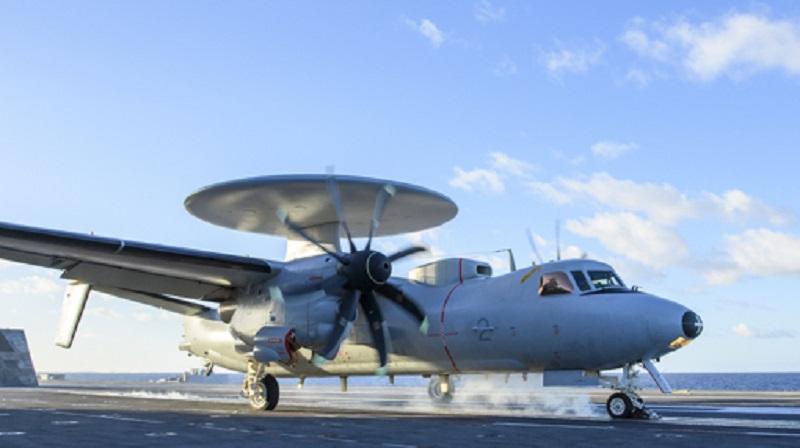An E2-C Hawkeye of the French Carrier Strike Group (CSG) conducted a 1st operational airborne early warning flight over Romania, contributing to AIR SHIELDING NATO. Their advanced detection capabilities enhance the Alliance deterrence and defense posture on her Eastern flank. Launched from the Charles de Gaulle aircraft carrier in the Mediterranean Sea, the Hawkeye benefited from a hot-pump refueling on ?? soil before resuming its Shielding mission. This extended 7-hour mission is highlighting the high level of coordination and trust between Allies. With its electronic exploitation system that identifies electromagnetic emissions from ships, aircraft or land-based assets.
The Northrop Grumman E-2 Hawkeye is an American all-weather, carrier-capable tactical airborne early warning (AEW) aircraft. This twin-turboprop aircraft was designed and developed during the late 1950s and early 1960s by the Grumman Aircraft Company for the United States Navy as a replacement for the earlier, piston-engined E-1 Tracer, which was rapidly becoming obsolete. The aircraft’s performance has been upgraded with the E-2B and E-2C versions, where most of the changes were made to the radar and radio communications due to advances in electronic integrated circuits and other electronics. Variants of the Hawkeye have been in continuous production since 1960, giving it the longest production run of any carrier-based aircraft.

The E-2 also received the nickname “Super Fudd” because it replaced the WF (later E-1) “Willy Fudd”. In recent decades, the E-2 has been commonly referred to as the “Hummer” because of the distinctive sounds of its turboprop engines, quite unlike that of turbojet and turbofan jet engines. In addition to U.S. Navy service, smaller numbers of E-2s have been sold to the armed forces of Egypt, France, Israel, Japan, Mexico, Singapore and Taiwan. Grumman also used the basic layout of the E-2 to produce the Grumman C-2 Greyhound cargo aircraft. The French Naval Aviation (Aeronavale) operates three E-2C Hawkeyes and has been the only operator of the E-2 Hawkeye from an aircraft carrier besides the U.S. Navy.
The French nuclear-powered carrier, Charles de Gaulle, currently carries two E-2C Hawkeyes on her combat patrols offshore. The third French E-2C Hawkeye has been upgraded with eight-bladed propellers as part of the NP2000 program. In April 2007, France requested the purchase of an additional aircraft. The Flottille 4F of the French Navy’s Aeronavale was stood up on 2 July 2000 and flies its E-2C Hawkeyes from its naval air station at Lann-Bihoue, deploying to the Charles de Gaulle. They took part in operations in Afghanistan and Libya. In September 2019 Florence Parly, French Minister of the Armed Forces, announced that three new E-2D Advanced Hawkeyes would be purchased in 2020 to replace the E-2Cs in service.
#ANTARES An E2-C Hawkeye of the #FrenchCSG conducted a 1st operational airborne early warning flight over ??, contributing to AIR SHIELDING @NATO . Their advanced detection capabilities enhance
the Alliance deterrence and defense posture on
her Eastern flank.#ProtectingtheSkies pic.twitter.com/5XnJ3FEGMk— French Carrier Strike Group (@French_CSG) November 25, 2022















